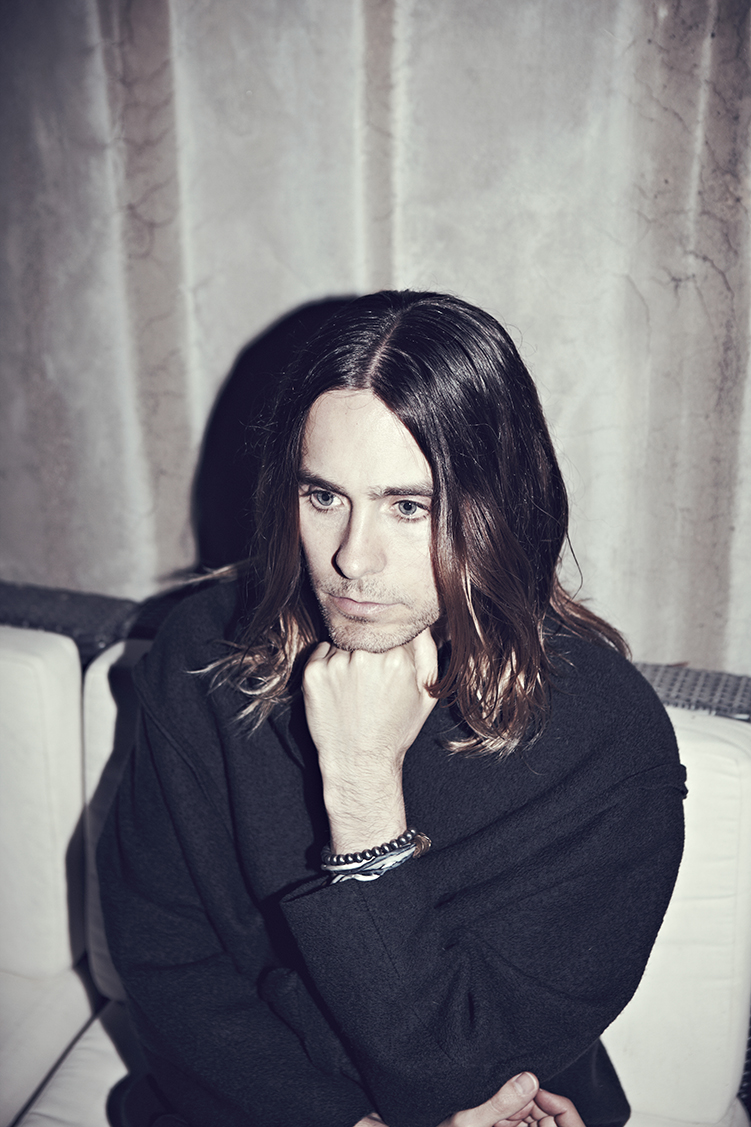
photos / Koury Angelo
stylist / Beau Barela
hair / Chase Kusero
grooming / Annie Esguerra
stylist assistants / Lamar Williams, Tiffany Perry

Jared Leto is engaging yet abstract, seductive in the manner of a mysterious boy glimpsed in the hallway at school. His face is unmistakably handsome, slightly at odds with its descriptions. The piercing gaze of technicolor blue eyes is the first thing to stand out. His shoulder length, dye-faded brown hair sits parted down the middle, framing his porcelin skin that still, after 41 years, shows the benchmarks of youth. He dresses and moves like a rock star—things that signal his impertinance for fashion. Somehow, you’re aware from the very beginning that no matter how you try, Leto’s probably going to know more about you than you do about him. Not meant to imply he uses this as a tactic to veil his nature, more just a comment on his cryptic charm and enigmatic ability to be interested while being even more interesting.
Leto first became known in 1994 for his portrayal of distant hearthrob Jordan Catalano in the cult-loved teen TV show, My So-Called Life. The same show that launched Claire Danes into the world. A short time after he became ordained into the scrutinzed line of actors-turned-musicians, applying his talents to form Thirty Seconds to Mars with his older brother Shannon and later joined by Tomo Miličević. Leto moved to Los Angeles in 1992 to pursue acting and has lived there ever since. “I had a couple hundred bucks, a backpack…and nothing much else than a shit ton of will. It was the decision of a lifetime. Very glad I made that choice,” Leto admits. “I certainly wouldn’t be here today if I didn’t make the decision to grab that backpack and work my way to California.”
It’s that same daring nature that reverberates through most all of his career choices over the last twenty years. Much about Leto’s critically-acclaimed film career, including REQUIEM FOR A DREAM, FIGHT CLUB, PANIC ROOM, AMERICAN PSYCHO, and PREFONTAINE is just that: daring. Daring, gruesome, beautiful, devastating, and audacious. After a six-year-long break from acting, Leto’s latest role is in DALLAS BUYER’S CLUB alongside Matthew McConaughey and Jennifer Garner—a role as daring as the ones before it. Leto plays Rayon, a transsexual drug-addict/dealer with AIDS who helps smuggle HIV meds in Texas. In Leto’s hands, anything can be inspiration, including perilously shedding more than thirty pounds for the role. With an already slender frame at the onset of his transformation, losing thirty pounds caused him to look like a gaunt skeleton ghost-man, á la Christian Bale in THE MACHINIST. He achieved the loss not through trainers or nutritionists, but with deprivation and self-starvation, same way he lost twenty-five pounds for REQUIEM FOR A DREAM.
“It was brutal, but necessary,” Leto says. “It informed so much about the character: the fragility, the way I walked and talked and even breathed. I wouldn’t recommend it though. Not fun. But transformative to say the least. I always love a good challenge.”

DALLAS BUYER’S CLUB and REQUIEM FOR A DREAM aren’t the only roles Leto transformed himself physically for. In CHAPTER 27, Leto played John Lennon’s chubby-faced killer, Mark Chapman– gaining 62 pounds for the role. As a long-time vegan, he couldn’t consume the red meat usually required to quickly pile on pounds. Instead he would microwave a pint of ice cream, add olive oil and soy sauce and drink it. Seriously. Because Leto gained all that weight by binging on gooey carbohydrates, he developed gout—a painful result of ballooning weight. But viscerally immersing himself into his art is a featured trait that’s made him famous.
Jared Joseph Leto was born in Louisianna, in a city called Bossier, some five hours from New Orleans. Early on, his single mother moved the family around from a commune in Colorado all the way to Haiti, to South America, to somewhere in between. His absentee father remains a mystery to the press, myself included. He attended high school at Flint Hill Prepatory School in Virginia, then enrolled in Philadelphia’s University of the Arts, but shortly thereafter discovered acting and transferred to the School of Visual Arts in New York before moving to Los Angeles at age 20. Less than two years later, he was an international teen heartthrob voted one of the Beautiful People from all the golden gossip rags who lauded him for his genetic perfection. So he worked even harder for roles that would break him out of teen-throb purgatory, with everything from straight-to-shelf indies to award-wining blockbusters.

Then while the acting world wasn’t watching, Leto went on to sell tens of millions of records, win a slew of music awards, break a Guiness World Record, travel the whole planet, get sued from his record label EMI (to the tune of $30 million) and direct a docmentary about it called ARTIFACT. Which took four years to make. Not that he minds all of that. “We took everything we’ve learned, the whole journey, and poured it into this new album.”
There’s the sense that Leto is slightly allergic to being pigeonholed, as people are likely to do to an actor-turned-musician, and that challenging popular perception is an undercurrent not so subtle in his artistic choices, both with acting and music. “Art is interesting when it provokes. It doesn’t have to be blatant or overt, but when it starts a conversation, I think it has done its job,” he comments. “I love to create. I make things for many different reasons but mostly because I am simply compelled. Warhol said something like ‘Don’t worry about what other people think, just make Art. And while they are trying to figure out if it’s good or bad, make more art.’ Good words. I think we should all defy expectations. Even our own.”
An artist should always be ahead, showing things that people don’t often see or haven’t ever seen. Opening doors on things which have been closed. Constantly evolving. Thirty Seconds to Mars has been one big living, breating evolution, the new album being the biggest progression for Leto, and his favorite work. Its narrative mirrors a maturated artist who’s increasingly connected with his ever-developing brand of personal truth and not an artifact of a previously perceived identity. “We’re exploring, we’re kind of redefining ourselves. There are certainly rock songs on the album, but we explored new territory, we challenged ourselves, we pushed ourselves. I think we broke new ground,” Leto says. “We’ve been a band for a really long time now and that’s great because you get to know each other and you get to know yourself. You live and you learn and we certainly have lived and learned a lot.”
The band’s evolution over four albums is “Up to the people who are listening to us to determine,” Shannon Leto says. Jared concurs: “I think that you make music, you give it away, let people spend time with it, then it becomes the soundtrack to their lives. They make a deep personal connection with it; it becomes theirs.”
From the start, TSTM got either reamed or ignored by the American ‘know-best’ music press, but, according to Leto, “It’s for a good reason.” There was an sizeable list of offenders that came before them, dilettante actors who put out lackadaisical junk-food music because they had the wherewithal to do so. But TSTM has been at it for some time, and I think that story has righted itself—after going multi-platinum, holding the World Record for Longest Concert Tour, and seeing their song “Up In the Air” debut in space aboard the Dragon spacecraft SpaceX CRS-2, the first ever commercial copy of music sent into space.
 Thirty Seconds To Mars recently released the album LOVE, LUST, FAITH + DREAMS in May 2013, the fourth in their cache, which was ambitiuosly birthed across many countries during the band’s perpetual touring. Recorded in Berlin, Tokyo, Paris, and multiple cities in India, the project was global. All those diverse locations naturally trickled into Leto’s psyche and helped shape the ebb and flow of the album.
Thirty Seconds To Mars recently released the album LOVE, LUST, FAITH + DREAMS in May 2013, the fourth in their cache, which was ambitiuosly birthed across many countries during the band’s perpetual touring. Recorded in Berlin, Tokyo, Paris, and multiple cities in India, the project was global. All those diverse locations naturally trickled into Leto’s psyche and helped shape the ebb and flow of the album.
“There’s a song called ‘Pyres of Varanasi’ which was inspired by Varanasi in India, a place where they’d been cremating the dead for five thousand years, along the Ganges River,” Leto says. “It’s a really interesting place. The travels, the touring, the exposure to different cultures, sights, sounds, people, places have all been a great influence on the album,” he explains. “When you’re traveling around the world with a group of people you love, putting up a show every night–it’s probably the most amazing thing I could imagine doing with my life. We all love it. If we didn’t, we wouldn’t do it. We certainly wouldn’t be able to do it as much as we do, if we didn’t absolutely love it. It’s a really great thing and we have a lot of gratitude for it.”
As an artist, Leto is influenced by the fringes of variegated cultures, as evidenced in the artists, photos and various works that incite and excite him that he posts almost daily in his blog From the Outerweb. Leto has also turned highlights of his blog into a popular printed book of the same name. He’s also influenced by Los Angeles culture, the city of a million dreams—where, as he puts it in City of Angeles, ‘Dreams aren’t made, they are won’. So what dream does Jared still wish would come true? “There are all kinds of dreams that I’m fighting to make a reality. Sometimes they’re small, sometimes they’re bigger, grander dreams, but I have lots of dreams. Lots of creative dreams,” he tells me, putting the emphasis on lots. “You know, LA is an interesting place. I, like many people, have a love/hate relationship with it, but if I hadn’t pursued my creative ambitions to LA, I wouldn’t be here sitting and talking to you. So it’s been a magical place for me.”
To their audience, Thirty Seconds to Mars can be somehow transportative—sometimes progressive, bombastic and dark, and at times, unabashedly anthemic. To their large group of worldwide followers known as The Echelon (whom Jared calls family), TSTM is life affirming. As evidenced in the band’s recent music video for their single “Do or Die,” which is a love letter fashioned to their devoted fanbase. Simply perusing the comments section on their YouTube channel, it’s evident the profound impact that fans feel from listening to their music.

“If I could ever make anyone feel better about their lives or about themselves, that’s an incredible thing. That’s a really nice thing to feel,” Leto says, with a thoughtful pause. “I certainly don’t count on it and I think very little of it has to do with me, but it’s really nice that music can do that for another person. We all have the ability to do that whether it’s greeting someone, smiling at somebody, or doing something kind for someone else. The great thing about music and playing live shows is that you really are being of service. You’re making something, you’re giving it away, and that’s a really nice thing to be able to do with your life. I’m really grateful to be able to do that, to make things and be able to share them.”
The fact that Leto and his band can broadly relate to their fans speaks volumes to Leto’s innate ability to make anyone feel acknowledged and important. It’s easy for him because, as he says, “I happen to be really curious about people and interested in what people have to say. I’m interested in the people who come to our shows and listen to our music. I’m curious about their lives. So, for this music video [Do or Die] – which is really a documentary about our summer of 2013 on the road – we had the opportunity to turn the camera on the people who are coming to those shows. We found all kinds of interesting stories. People shared really deep and personal parts of their lives with us and it made for a wonderful little film.”
He’s polite when needed, slightly sarcastic, but also boisterous–foot on the accelerator most times. Definitely not shy, even as he quietly takes moments in between sentences to gather his thoughts before announcing them, that famous Catalano pause. “[In the beginning] the vision was to just make music and art and do creative things with my brother. To tour and travel and to make albums together. To share an adventure. And I have to tell you, it’s been an absolute dream. We never ever expected the level of success that we have now. It’s absolutely mind blowing. In some ways this wasn’t supposed to happen, ya know? It’s impossible, isn’t it.” Leto states, rather than asks. “When we were in the garage for years and years, our only hope was to be able to stand on a stage in some tiny little club and be able perform the songs we had written. We didn’t care if anyone even showed up, we just wanted to do it for the sake of doing it. It’s incredible what’s possible when you work and dream. Very thankful.” This coming from the dude who proved you can be a real rock star and big movie star. No offense, Timberlake.
As a muscian, Leto is of avant-garde grain, never being anyone’s darling–an approach that has undoubtedly informed the pastiche of his acting pursuits. Taking time away from acting only served to incubate his film creativity until he found the right project. His commitment to his band resulted in having to turn down a few high-profile acting gigs along the way. “I learned a lot by not making a film for five or six years. I think in many ways, I began again. That break made me a better actor,” Leto admits. “For me, when I choose a role, it’s based on the script, the director, the cast, the scenes, and if I think I can contribute something. I don’t make a lot of movies because I’m really busy with the band. I didn’t plan on taking six years off, but we were touring so much and having more success than we ever dreamed possible. It was exciting to have just made this film, it was a really special experience.”
In addition to acting and music-making, Leto also directs. Aside from his upcoming music documentary, ARTIFACT, he directs all of his music videos, under the moniker Bartholomew Cummins [a Dr. Suess character], most of which have a run-time longer than five minutes. The majoirity of those videos have gone on to be nominated and win VMAs.
A defiant step that sets him apart from other actor-come-rockers is that Leto prefers to not use his movie-star-wattage to promote his band. In fact, he has refused to play at venues if they’ve used his name to promote the band. Promoters are forbidden from placing Leto’s name on posters or listings. For him, playing live for a huge audience is a privilege not to be abused. Exploiting his position as a star just to gain exposure is contrary to the significance he places on musical merit. Also, it’s often more of a curse than a blessing to have a famous member attached to the band’s name. Sorry, Keanu Reeves.
“[When] people come to see us play, they’re with a bunch of strangers who have also made a deep and personal connection to the music, and then they hear something together. It’s a pretty unique, fascinating occurrence. It’s the coming together of people from very disparate backgrounds that are all relating and sharing a common belief and celebrating something together,” he says. “We have a lot of gratitude for what we do and feel really fortunate to be able to tour the world and share our music with people.”
Leto is a man of several different worlds: boundary-pushing rock star, mysterious movie star, professional painter, highbrow art lover, labeled ladies’ man. He’s heralded as both actor and musician, a fine feat in this day and age…but Jared Leto is still simply Jared Leto, the many sides to which we can only speculate. He doesn’t feel any need to explain, his art will just have to speak for him. “Artists should do whatever the fuck they wanna do. That’s why they’re artists. No. Rules. At. All. I love to make things. And to share those things with people. Film. Music. Photography. Art. Doesn’t matter. It all comes from the same place.”
